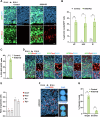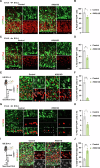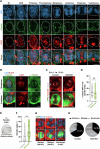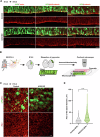Kinesin-like motor protein KIF23 maintains neural stem and progenitor cell pools in the developing cortex
- PMID: 39632980
- PMCID: PMC11729872
- DOI: 10.1038/s44318-024-00327-7
Kinesin-like motor protein KIF23 maintains neural stem and progenitor cell pools in the developing cortex
Abstract
Accurate mitotic division of neural stem and progenitor cells (NSPCs) is crucial for the coordinated generation of progenitors and mature neurons, which determines cortical size and structure. While mutations in the kinesin-like motor protein KIF23 gene have been recently linked to microcephaly in humans, the underlying mechanisms remain elusive. Here, we explore the pivotal role of KIF23 in embryonic cortical development. We characterize the dynamic expression of KIF23 in the cortical NSPCs of mice, ferrets, and humans during embryonic neurogenesis. Knockdown of Kif23 in mice results in precocious neurogenesis and neuronal apoptosis, attributed to an accelerated cell cycle exit, likely resulting from disrupted mitotic spindle orientation and impaired cytokinesis. Additionally, KIF23 depletion perturbs the apical surface structure of NSPCs by affecting the localization of apical junction proteins. We further demonstrate that the phenotypes induced by Kif23 knockdown are rescued by introducing wild-type human KIF23, but not by a microcephaly-associated variant. Our findings unveil a previously unexplored role of KIF23 in neural stem and progenitor cell maintenance via regulating spindle orientation and apical structure in addition to cytokinesis, shedding light on microcephaly pathogenesis.
Keywords: Apoptosis; Cytokinesis; Kinesin Motor Proteins; Microcephaly; Neurogenesis.
© 2024. The Author(s).
Conflict of interest statement
Disclosure and competing interests statement. The authors declare no competing interests.
Figures












Similar articles
-
Cenpj Regulates Cilia Disassembly and Neurogenesis in the Developing Mouse Cortex.J Neurosci. 2019 Mar 13;39(11):1994-2010. doi: 10.1523/JNEUROSCI.1849-18.2018. Epub 2019 Jan 9. J Neurosci. 2019. PMID: 30626697 Free PMC article.
-
KIF20A/MKLP2 regulates the division modes of neural progenitor cells during cortical development.Nat Commun. 2018 Jul 13;9(1):2707. doi: 10.1038/s41467-018-05152-1. Nat Commun. 2018. PMID: 30006548 Free PMC article.
-
Radmis, a novel mitotic spindle protein that functions in cell division of neural progenitors.PLoS One. 2013 Nov 8;8(11):e79895. doi: 10.1371/journal.pone.0079895. eCollection 2013. PLoS One. 2013. PMID: 24260314 Free PMC article.
-
Progenitor genealogy in the developing cerebral cortex.Cell Tissue Res. 2015 Jan;359(1):17-32. doi: 10.1007/s00441-014-1979-5. Epub 2014 Aug 21. Cell Tissue Res. 2015. PMID: 25141969 Review.
-
Non-canonical functions of the mitotic kinesin Eg5.Thorac Cancer. 2018 Aug;9(8):904-910. doi: 10.1111/1759-7714.12792. Epub 2018 Jun 21. Thorac Cancer. 2018. PMID: 29927078 Free PMC article. Review.
Cited by
-
Hedgehog signaling controls astral microtubules and mitotic spindle orientation in neural progenitors and iPSCs.Front Cell Dev Biol. 2025 Jun 6;13:1582924. doi: 10.3389/fcell.2025.1582924. eCollection 2025. Front Cell Dev Biol. 2025. PMID: 40546321 Free PMC article.
-
The midbody and midbody remnant: from cellular debris to signaling organelle with diagnostic and therapeutic potential.Mol Biol Cell. 2025 Jul 1;36(7):re4. doi: 10.1091/mbc.E25-03-0120. Epub 2025 May 28. Mol Biol Cell. 2025. PMID: 40434898 Free PMC article. Review.
-
Canonical Hedgehog Signaling Controls Astral Microtubules and Mitotic Spindle Orientation in Neural Progenitors and iPSCs.bioRxiv [Preprint]. 2025 Feb 25:2025.02.23.639780. doi: 10.1101/2025.02.23.639780. bioRxiv. 2025. Update in: Front Cell Dev Biol. 2025 Jun 06;13:1582924. doi: 10.3389/fcell.2025.1582924. PMID: 40060449 Free PMC article. Updated. Preprint.
References
MeSH terms
Substances
Grants and funding
LinkOut - more resources
Full Text Sources
Molecular Biology Databases

